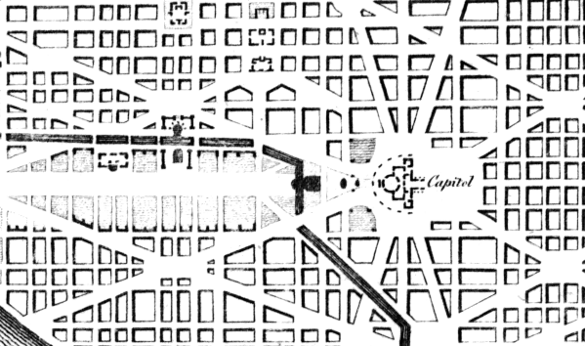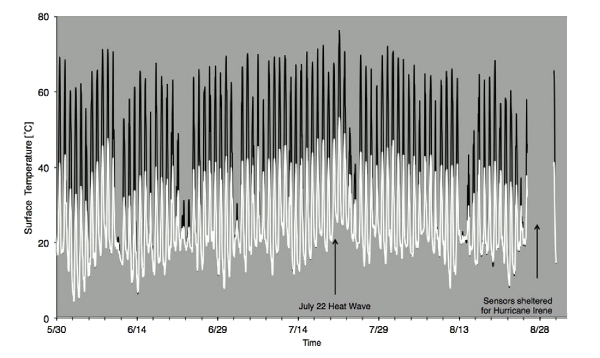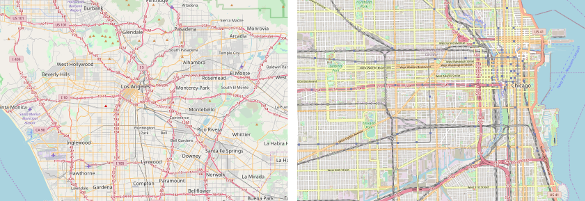Heat Islands
June 11, 2018
Model railroading was once a popular
pastime.
Young Sheldon has a large model railroad setting in his
parents' garage, and it's been said that early
computer clubs evolved from model railroad clubs, such as the
MIT Tech Model Railroad Club, since these involved tinkering with
electrical circuits,
relay logic, and crude
automation. As
children, my
brothers and I were
gifted with a
Lionel train set, the powerful variable
voltage transformer of which I was happy to have for subsequent
science experiments. As an indicator of the decline of model railroading as a hobby, Lionel petitioned for
Chapter 11 bankruptcy protection in 2004, to recover by 2008.
A model railroad will necessarily have a
circular track to allow continuous operation. The circular track will traverse
bridges and
tunnels in modeled
rural areas, but a
city setting will often be incorporated in its interior. Although the tracks are circular, the
streets of the cityscape are invariably arranged as a
rectangular grid. This grid layout is the street pattern of nearly every city.
The
street plan of the United States Capital is generally a grid, although its designer,
French military engineer,
Pierre Charles L'Enfant (1754-1825), mixed things up a bit with some
diagonal avenues that intersected some grid points at
circles and
plazas (see figure).

L'Enfant's plan for the area near the US Capitol building. A March, 1792, engraving on paper from the US Library of Congress, via Wikimedia Commons
It's commonly known that cities are warmer than their
suburbs, an effect known as
urban heat island. This effect can be quite dramatic, amounting to a
differential temperature between rural and
urban areas up to 5
°C (9
°F) during
night hours. The principal cause of this effect is the structures built on the once
natural landscape, although
waste heat from the
energy used by the city
population is another factor. Anyone who's traversed an
asphalt parking lot in a city knows that such dark expanses are very
efficient in storing the
Sun's infrared energy, absorbing more than 75% of
solar radiation.
As I wrote in a
previous article (White Roofs, March 19, 2012), One way to mitigate heat island effects is by using
building materials with a high
albedo, the
technical term for the
ratio of
reflected to received
irradiance. Fresh
snow has an albedo that's generally above 0.8, while fresh asphalt has an albedo of about 0.05. The
roof of my house is
white, which should keep me cooler in the
summer. You can see a portion of my roof in an
earlier article (Partial Solar Eclipse at New Jersey, August 24, 2017)
While I don't have supporting
data for the white roof principle for my own house,
NASA and various
New York City organizations tested this idea in 2012. They examined the differences between roofs covered with white and dark roofing materials and found that an
inexpensive white roof covering can mitigate the urban heat island effect. Their data for side-by-side roof patches on the
Museum of Modern Art showed that a white painted roof surface was 42 °F (23 °C) cooler than an unpainted black roof.[3]

A comparison of white (white) and black (black) roof temperatures atop the Museum of Modern Art in New York City during a roof surfacing materials test, June-August 2011. The white surface was produced using an acrylic paint coating promoted by the New York City CoolRoofs program.(NASA image/Stuart Gaffin, et al.)[2]
Radiation energy loss is most effective at very high temperatures, since it follows the
Stefan-Boltzmann law that states that the radiated power from a
black body is directly
proportional to the
fourth power of temperature; viz,

where
j is the black-body
emissive power,
T is the
absolute temperature, and
σ, called the
Stefan-Boltzmann constant, 5.67037 x 10
−8 watt meter−2 kelvin
−4, can be expressed as a combination of some
fundamental constants,

in which
k is the
Boltzmann constant,
h is
Planck's constant, and
c is the
speed of light. In the real world, nothing exists in
isolation. At the same time an object is radiating energy, it's absorbing the radiant energy from nearby objects.
Water exposed to a clear night sky on a cold night might
freeze, since it's radiating a lot more energy than it's absorbing, but that same water in a
bowl on your
front porch would stay
liquid, since its thermal environment is warmer.
A team of
engineers from the
Massachusetts Institute of Technology (Cambridge, Massachusetts), the
Universite Paris-Saclay (Orsay, France), the
University of California - Irvine (Irvine, California), and
Aix-Marseille Université (Marseille, France), has examined how the
texture of a city, as measured by the distribution of buildings and their sky exposure, affects the nocturnal urban heat island effect.[4-6] They examined city layouts and the temperature differences between urban and rural environments over the course of several years for more than fifty cities worldwide using a heat radiation scaling
model to demonstrate a strong
correlation between the overnight heat storage and city texture.[4-6]
To underscore the idea that mitigating the heat island effect an important problem, a 1995
Chicago heatwave of 100+ degrees (F)
killed an estimated 739 people.[6] In response, cities have looked at reflective construction materials, as noted above,
planting trees, and
painting road surfaces white.[6]
Roland J.-M. Pellenq, a Senior Research Scientist at MIT and an
author of this study, realized that the relative positioning of buildings might offer insight into the effect, just as the arrangement of
atoms on a
surface can determine
physical properties.[6]
The research team looked at nighttime data, only, since night offered a simplified
environment in which heat was just being lost and not also stored. They used a dataset of hourly temperature readings from several years of measurements from 22
weather stations of the
National Oceanic Atmospheric Administration in 14 US cities to calculate the differential temperature with respect to representative rural areas.[5-6]
They used
Google Maps to
analyze how buildings were organized within a three-
mile radius of the stations and used a
radial distribution function, the
probability distribution of finding an object at a given distance from another object, to determine the "
crystallinity" of the building arrangement.[5-6] A grid pattern had a crystallinity of 1, while a completely disordered, liquid-like, pattern had a crystallinity of 0. The crystallinity of most cities ranged from 0.5-0.9, with Chicago having the highest, and
Los Angeles having the lowest (see figure).[5-6]

Street layouts of Los Angeles (left) and Chicago (right). The texture of Los Angeles resembles a liquid, while that of Chicago is relatively crystalline. Chicago shows a greater urban heat island effect than Los Angeles. (Images from OpenStreetMap.org. Click for larger image.)
While this simple model did not include building
height or
volume, a strong correlation was demonstrated with enhanced nighttime temperature.[5] A more advanced model that incorporated the
areal density of buildings and their height, and thereby their view of the sky, also showed that city "texture" will influence the urban heat island effect.[5] It's
conjectured that this texture effect arises from a combination of radiant heat trapping, and by decreased
airflow in multiple directions in grid-like layouts.[6] As Pellenq and his
colleagues admit, there are opportunities to improve their model by adding other factors.[5-6] All this may yield a
city planning tool for urban heat island mitigation.
References:
- Steven Levy, The Tech Model Railroad Club, Wired, November 21, 2014.
- S R Gaffin, M Imhoff, C Rosenzweig, R Khanbilvardi, A Pasqualini, A Y Y Kong, D Grillo, A Freed, D Hillel and E Hartung, "Bright is the new black - multi-year performance of high-albedo roofs in an urban climate," Environmental Research Letters, vol. 7 no. 1 (January-March 2012), Socument No. 014029.
- Patrick Lynch, "Bright Is The New Black: New York Roofs Go Cool," NASA Goddard Space Flight Center Press Release, March 7, 2012.
- J. M. Sobstyl, T. Emig, M. J. Abdolhosseini Qomi, F.-J. Ulm, and R. J.-M. Pellenq, "Role of City Texture in Urban Heat Islands at Nighttime," Phys. Rev. Lett., vol. 120, no. 10 (March 9, 2018), Article no. 108701, DOI:https://doi.org/10.1103/PhysRevLett.120.108701.
- David Lindley, "City Structure Influences Nighttime Temperatures," Physics, vol. 11, no. 25 (March 9, 2018).
- Linda Poon, "Street Grids May Make Cities Hotter," Citylab.com from The Atlantic Monthly Group, April 27, 2018.
Linked Keywords: Model railroading; hobby; pastime; Young Sheldon; parent; computer club; Massachusetts Institute of Technology; MIT; Tech Model Railroad Club; electrical circuit; relay logic; automation; child; children; brother; gift; Lionel, LLC; voltage; transformer; science; experiment; Chapter 11 bankruptcy protection; circle; circular; bridge; tunnel; rural area; city; street; rectangle; rectangular; regular grid; L'Enfant Plan; street plan of the United States Capital; French; military engineer; Pierre Charles L'Enfant (1754-1825); diagonal; avenue; traffic circle; plaza; engraving; paper; US Library of Congress; Wikimedia Commons; suburb; urban heat island; subtraction; differential; temperature; urban area; Celsius; °C; Fahrenheit; °F; night; natural landscape; waste heat; energy; population; asphalt; parking lot; efficiency; efficient; Sun; infrared; sunlight; solar radiation; building material; albedo; technology; technical; ratio; reflection (physics); reflected; irradiance; snow; roof; white; summer; data; NASA; New York City; inexpensive; Museum of Modern Art; temperature; roof shingle; surfacing material; acrylic paint; New York City CoolRoofs program; Stuart Gaffin, et al.; Stefan-Boltzmann law; black body; proportionality (mathematics); proportional; fourth power; emissivity; emissive power; absolute temperature; Stefan-Boltzmann constant; watt; meter; physical constant; fundamental constant; Boltzmann constant; Planck's constant; speed of light; isolated system; isolation; water; freezing; freeze; bowl; front porch; liquid; engineer; Universite Paris-Saclay (Orsay, France); University of California - Irvine (Irvine, California); Aix-Marseille Université (Marseille, France); surface finish; texture; mathematical model; correlation; Chicago; heatwave; kill; sowing; planting; tree; paint; Roland J.-M. Pellenq; author; atom; surface; physical property; environment; weather station; National Oceanic Atmospheric Administration; Google Maps; analysis; analyze; mile; radius; radial distribution function; probability distribution; crystallinity; Los Angeles; Chicago; liquid; crystalline; OpenStreetMap.org; height; volume; areal density; conjecture; airflow; colleague; city planning.